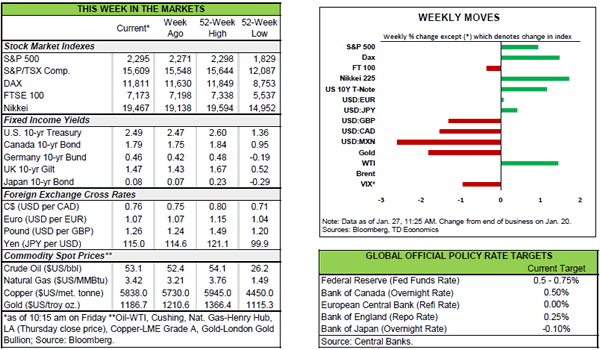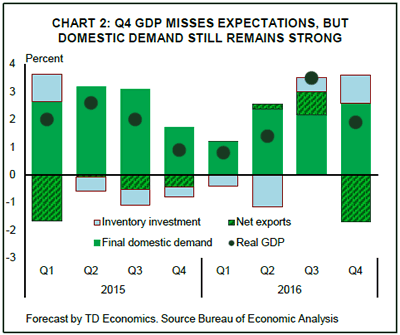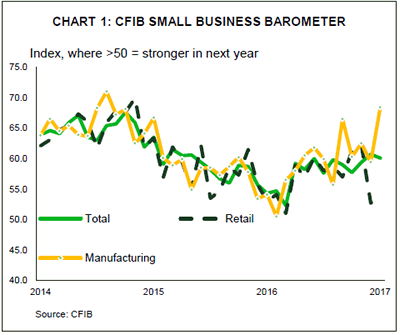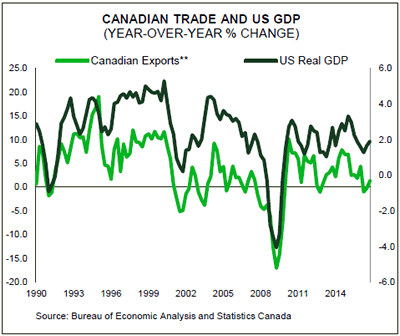HIGHLIGHTS OF THE WEEK
United States
- Domestic data took a backseat to this week’s developments out of the oval office, where several executive orders were signed by President Donald Trump. Markets cheered on the approval of the Keystone XL and Dakota Access pipelines, but were less thrilled about the administration’s withdrawal from the TPP and signal to open negotiations on NAFTA.
- Data out of the U.S. was somewhat less inspiring, with several misses in December following very strong prints in the prior month. The most noteworthy release, U.S. fourth quarter GDP, fell shy of expectations, but nonetheless painted a picture of a solid domestic demand, with consumer spending growing by 2.5%.
- Next week will be much more exciting, with the FOMC convening for their first meeting of the year. Additionally, a slew of first-tier economic data will be released, including the highly anticipated employment report due out next Friday.
Canada
- Of the many executive orders signed by U.S. President Donald Trump this week, one could prove meaningful for Canada – reopening the request to build the Keystone Pipeline.
- If approved, the pipeline could be a positive for Canadian economic growth, whereas the re-opening of NAFTA provides a bit more uncertainty and downside risk.
- Communication suggests that renegotioating NAFTA is on the docket. However, with NAFTA still in place, the near-term outlook for the Canadian economy remains upbeat, particularly as strong underlying momentum in the U.S. consumer will help boost Canadian exports. As such, despite the rhetoric around NAFTA, markets and businesses remained relatively upbeat in Canada.

UNITED STATES – ALL EYES ON POTUS
Economic data did little to set the tone for markets this week. Instead, market participants globally paid close attention the new President’s executive orders and Twitter messages in an attempt to discern President Donald Trump’s agenda. To kick things off, the administration directed its attention towards the "America first" trade agenda, with President Trump signing an executive order to withdraw the U.S. from the previously signed Trans Pacific Partnership. Adding fuel to the fire, the President also put NAFTA partners on alert, signaling that steps would be taken to open negotiations up in the coming days.
Nonetheless, the deterioration in risk sentiment that followed proved short-lived. President Trump quickly switched gears towards his mandate on deregulation, signing an executive order approving the Keystone XL and Dakota Access pipelines while putting forth a list of potential infrastructure projects. Markets applauded this development, and a rally in U.S. equities ensued, helped in part by strong earnings, which pushed the Dow Jones Industrial Average above the coveted 20,000 mark by mid-week.
While developments out of the oval office were still unclear as far as their precise impacts on the economy, domestic economic data was somewhat less inspiring, albeit still strong. For one, U.S. existing home sales fell by 2.8% to 5.49 million annualized in December, a pace slightly below the estimated 5.52 million level. The pullback, was largely anticipated as buyers rushed to lock in rates before they climbed any further, and in doing so, brought demand forward at the expense of future sales (Chart 1). Furthermore, initial jobless claims also disappointed, rising by 9k more than what was expected to 259k in the week ended Jan. 21, and new home sales tumbled 10.4% in December.
Global data out this week was more positive. Growth for the fourth quarter in the UK came in a hair above consensus at 0.6% q/q and PMIs across Europe broadly beat expectations. Perhaps the most noteworthy data release this week was the scorecard for the American economy at the end of 2016. The first reading on fourth quarter GDP came in at 1.9%. While falling short of the median consensus estimate of 2.2%, much of the weakness stemmed from a largerthan- expected rebound in imports (Chart 2). The details on domestic demand were much stronger, with consumer spending growing by 2.5% as spending on durable goods posted a third consecutive stellar quarter (10.9%).
While there were some minor speedbumps in this week’s data, the good news is that the domestic economy still appears to be on a good footing. Nonetheless, uncertainty will certainly cloud the outlook as policy changes continue to make their way out of Washington D.C. This theme will likely be highlighted next week in the statement following the Federal Reserve’s first FOMC meeting of the year. This provides further reason to maintain a gradual hiking cycle, something Janet Yellen recently reiterated. Despite the Fed moving ever closer to its dual-objectives of full-employment and medium-price inflation of 2%, the Fed Chair believes that moving earlier but at a more measured pace is the preferred path, while waiting too long risks more rapid rate rises in the future – something that could potentially tip the economy into recession.


CANADA – ONE STEP FORWARD FOR OIL, ONE STEP BACK FOR TRADE
President Donald Trump has been in office just five short days and he’s already signed many executive orders, one of which could prove meaningful for Canada – reopening the request to build the Keystone Pipeline. And, communication so far suggests that the renegotion of NAFTA is on the docket.
The pipeline issue is less of a black box. The project still needs to go through a review process and perhaps meet new hurdles, but appears more likely to be approved. If so, it will give Canadian oil companies better access to the U.S. market . Still, even if it is not approved, the Canadian economy is likely no worse off than it was before and attention will turn back to other pipeline projects.
The re-opening of NAFTA provides a bit more uncertainty and downside risk. So far, the focus of the Trump administration has been on Mexico and the size of America’s trade deficit with the country. Fortunately, Canada, has, for the most part, been left out of the discussion. As we point out in a report this week, the United States does not have a trade deficit with Canada. While Canada has a slight surplus in goods exports, it has a deficit in services, which pushes the overall balance in the U.S.’s favour. Still, we have to pay attention. Exports to the United States represent one fifth of the entire Canadian economy and any thickening of the border would represent a meaningful downside risk to the outlook.
For all the rhetoric around NAFTA, markets and businesses remained relatively upbeat in Canada. The Canadian dollar ended the week around 76 U.S. cents, following a small dip late last week. The S&P/TSX has risen to historically high levels, and didn’t skip a beat with Trump’s executive order re-opening NAFTA this week. The CFIB small business barometer showed that small business sentiment remained relatively stable in January. The index remained at 60, which is higher than the lows hit in 2015 following the collapse of oil, but still significantly lower than the highs reached in 2014 (Chart 1). Digging deeper into the details of the report suggests that businesses tied to domestic demand (construction and retail) remained more somber about the outlook, whereas optimism among industries tied to trade (wholesale, manufacturing and transport and warehousing) saw significant improvements in confidence in January.
With NAFTA still in place, the outlook for the Canadian economy looks fairly bright in the near-term. Exports picked up significant momentum towards the end of last year, and next week’s monthly real GDP report is expected to show a healthy gain in economic activity tied to international trade. Overall, it is estimated that the Canadian economy grew by over 2% annualized in the fourth quarter of the year, building on a strong 3.5% gain in the prior quarter. More importantly, the U.S. economic data out on Friday showed continued momentum in consumer spending and a rebound in investment, areas of the economy that are generally positive for demand for Canadian made goods. For now, trade will remain a positive story in Canada for 2017. We will revisit the trade story once more details on NAFTA renegotiations become available.















